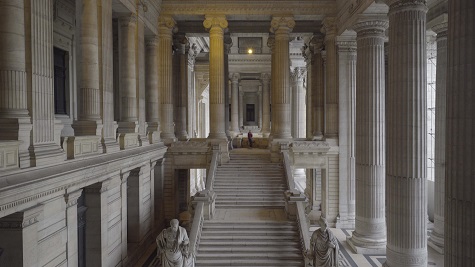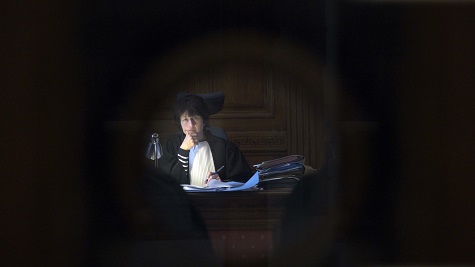
Carey Young, still from Palais de Justice, 2017, HD video, 17 mins., 58 secs., Courtesy of the artist and Paula Cooper Gallery, © Carey Young
London-based artist Carey Young’s new video Palais de Justice is a cinematic glimpse into the Brussels courthouse of the same name. The video begins with a lone man walking down a vast staircase. Hands in the pockets of his track pants, he appears far more casual than the 19th–century architecture that surrounds him. Over time, the video shifts from distant shots of people walking through the interiors to more intimate views of female judges at work. Observing them through smudged portholes in courtroom doors, the camera captures the judges in moments of authoritative posturing during trials: they stroke their chins, remove their glasses, and gaze across the room deep in thought.
The women we see through the portholes are, in fact, actual judges and not actors. Young shot Palais de Justice “guerilla” style for three weeks over a period of two years, catching the daily activities that occurred throughout the building. She did not begin the project with a preplanned narrative but instead pieced her footage together afterwards to form a more poetic picture of the courthouse. Young especially wanted to highlight the presence of the female judges to subvert common assumptions about who holds the power of law. Rather than seeing men in charge, we see only women occupying these prestigious societal roles.

Carey Young, still from Palais de Justice, 2017, HD video, 17 mins., 58 secs., Courtesy of the artist and Paula Cooper Gallery, © Carey Young
In a brief conversation, Young explained to me that Palais de Justice marks an artistic departure for her. While her work often takes the form of conceptual text, performance, and photography, the video is much more metaphorical and dreamlike. Young further explained that she wanted the video to highlight the intent of the architect to express the “sublime scale of the law.” This is apparent in how Young has installed the work inside the gallery: the projection takes up an entire wall and, as a result, immerses the viewer. Surrounded by a soundtrack of vocal echoes and footsteps playing alongside the video footage, one sees the landmark building itself as another character among the judges and courthouse visitors.
The Palais de Justice was designed by architect Joseph Poelaert in celebration of Belgium’s independence from the Netherlands. A massive structure—over 200,000 square feet with 27 large courtrooms—it remains one of the largest courthouses in Europe. For Young, the monumental qualities of the building made it a perfect case study for her ongoing meditations on the performative nature of law. The architectural elements, especially the oculi through which we gaze, draw attention to our own roles as witnesses to the law in action. It makes us think not only about the institution of law but also about who has the power to exercise it.
With this in mind, Palais de Justice makes me think about how buildings shape our attitudes and behaviors. How does architecture command this kind of power? Does the architecture of a courthouse differ from, for instance, that of an art museum? What might a courthouse of the future look like?
These are only a few of the questions that Young’s powerful video raises. See it yourself at the DMA, along with other new and existing works by Carey Young, in Carey Young: The New Architecture, now through April 9.
Kelly Filreis is the McDermott Graduate Intern for Contemporary Art at the DMA.